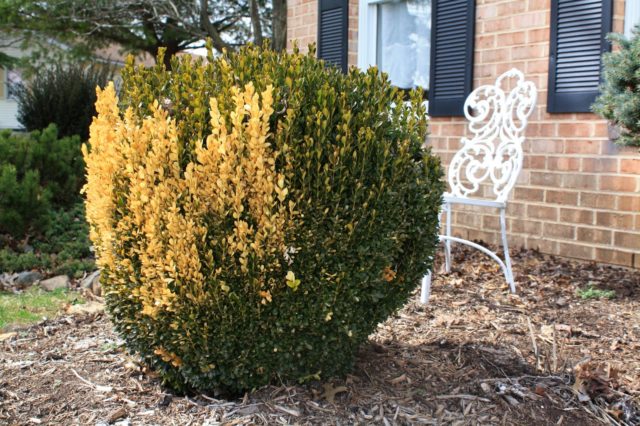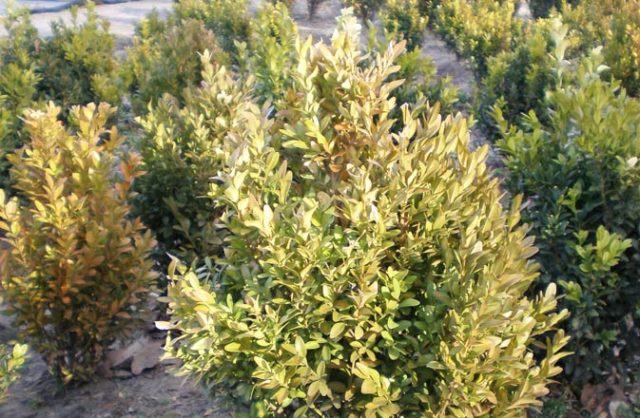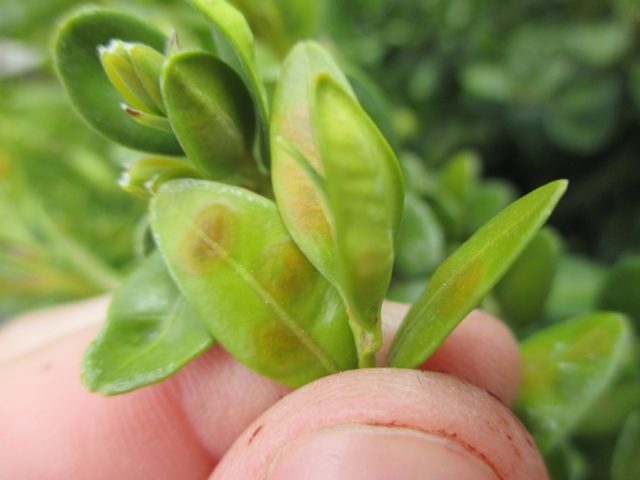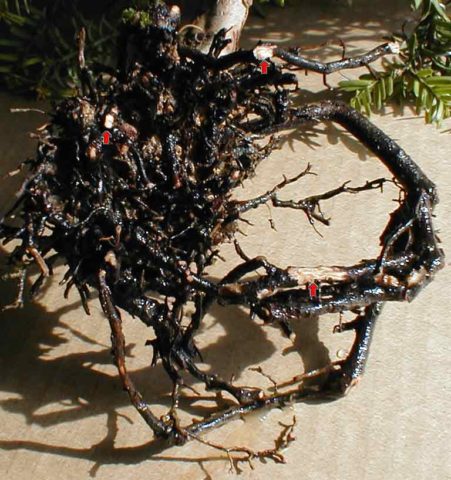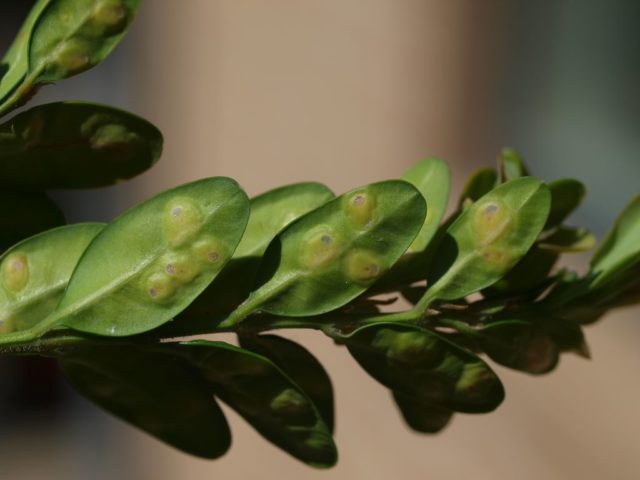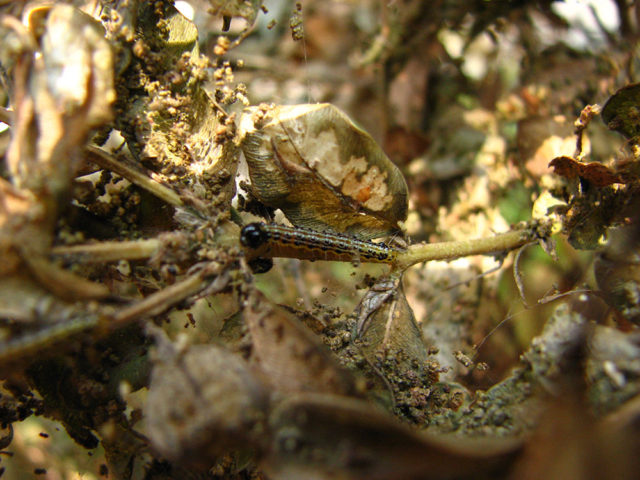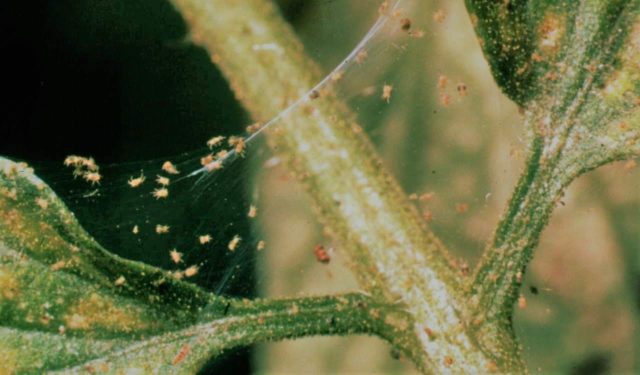Content
Finding that the boxwood has turned yellow is a very unpleasant discovery for any gardener. After all, it takes years to grow even a small beautiful bush. The loss of decorativeness is not the worst consequence of yellowing of evergreen leaves. If you do not understand the causes of chlorosis in time and do not correct the situation, over time you can lose the entire plant.
Why boxwood dries and turns yellow
The evergreen boxwood, irreplaceable in landscaping, is easy to shape into beautiful shapes, dense hedges or curbs. Small hard foliage pleases with a bright color all year round. But boxwood grows extremely slowly - under the best conditions, its annual growth does not exceed 15 cm.Therefore, it is a serious problem to find that the leaves have turned yellow or whole branches have dried up.
The fix is sometimes very simple by changing the care of the boxwood. In other cases, complex procedures will be required, but first you need to establish the probable cause from the many possible ones.
Adverse climatic factors
Boxwood is a hardy plant that can cope with heat and cold, but sudden changes in weather or growing conditions can weaken the plant. Leaves are the first to react to stress factors. If box trees turn yellow, then one of these problems has arisen:
- A sharp change in illumination after winter. The bright spring sun can burn the awakening shoots while the roots are not yet fully functional. If you do not shade the boxwood in the first sunny days, the leaf plates around the circumference of the bushes will inevitably turn yellow.
- Leaves can take on a reddish tint in the hot summer period when two factors coincide: bright midday lighting and drying out of the topsoil near the trunk. Boxwood is thermophilic, but at temperatures above + 35 ° C it requires partial shade or diffused lighting.
- For central Russia, you should choose specially bred frost-resistant varieties. The first sign of hypothermia is if the tips of the leaves turn yellow. Boxwood easily tolerates mild winters, but with severe cold snaps, the entire part that is not covered with snow can freeze out.
Improper care
It is not only natural factors that make boxwood leaves turn yellow. Sometimes the care does not meet the needs of the plant, to which the bushes react with a change in color.
The most common causes of yellowing boxwood:
- Insufficient hydration. Boxwood is not picky about watering, but prolonged drying of the topsoil is contraindicated for it. It often happens that the boxwood turns yellow after pruning, if the required watering after the procedure is missed.
- Dry air. With insufficient humidity, it is useful to spray young bushes from a spray bottle. This will stop yellowing. It is useful to combine the procedure with foliar feeding.
- Excessive hydration. Stagnation of water in the soil is unacceptable when growing box trees. Systematic overflow provokes root rot. In this case, the leaf plates turn yellow gradually, there are signs of general wilting.
- Lack of nutrition. The lack of trace elements can be manifested by the fact that the tips of the leaves or the interveinal space have turned yellow.Over time, the entire green part changes color, and the plant may die. Usually yellowing is associated with a lack of phosphorus or potassium.
- If the boxwood is yellow mainly in the middle of the bush, and there is also a color change in the lower part, then the plant lacks nitrogen.
Diseases and pests
The most dangerous diseases for the culture are fungal infections. Two types of infection are most difficult to defeat: tissue necrosis and root rot. The smallest spores of the fungus are carried by air masses and mainly affect weakened plants in conditions of excessive moisture.
Necrosis
The disease manifests itself in early spring. If the youngest shoots turn red, and then turn yellow and dry, then the matter is precisely in the infection with the fungus. Affected bushes should be treated with fungicides, dried shoots should be removed and burned. Deep pruning is carried out to healthy areas of wood, after which the treatment with drugs is repeated.
Root rot
The infection is also caused by a fungus present in the soil. The disease is actively developing with excessive watering with stagnant moisture, mainly in the cold season. Root disease is manifested by a general inhibition of growth and sluggishness of the boxwood. As root rot progresses, leaves on individual shoots turn yellow, and then the whole plant.
At an early stage of the disease, when only individual branches have turned yellow, the boxwood can be removed from the soil, cut off all damaged areas of the roots, and replace the substrate in the planting pit with the obligatory laying of drainage. Sand must be mixed with fresh soil. At a later stage, with the loss of more than half of the green mass, it is almost impossible to save the boxwood.
Boxwood gall midge
Pest infestation first appears as yellow swellings on the leaf surface. On the back of the plate, tubercles are formed, in which worm-like orange larvae develop. Young gall midges feed on boxwood leaves, and for the winter they go deep into the woods in order to come to the surface in spring and repeat the breeding cycle in the stage of adult insects.
With prolonged infection, leaves and whole shoots dry out in box trees. Gall midges should be dealt with in a complex way, removing the affected areas of the shoots, carrying out a double treatment with chemicals (Tagor, Aktara) with a break of 10 days. Be sure to spray the plants in the next season at the beginning of May, when the surviving gall midges enter the breeding season.
Boxwood moth
An insect similar to a small moth, the most dangerous enemy of boxwood plantings in Europe, came to the territory of Russia in 2012, but managed to spread over large areas and destroy hectares of groves on the southern coast of the Black Sea. Once on plants, insects multiply rapidly, covering the bushes with sticky cobwebs. Boxwood leaves turn yellow and curl, they are eaten by small bright moth caterpillars.
If a pest is detected, the planting is urgently treated with specialized biological products. Moreover, for insects at different stages of development, separate insecticides are provided: Dimilin, Decis pro, Fastak, Fury. Spray the crown, trunks and all the soil near the trunk, as well as between the plants.
Spider mite
If the leaves become covered with yellow blotches, and later lose their color and dry, you should check the boxwood for the presence of small mites on the underside of the leaf plates.Pests appear in hot weather with low air humidity and feed on sap from living leaves.
In the early stages of infestation, microscopic mites can be washed off the plants with soapy water. This way you can prevent the entire bush from turning yellow. In case of severe lesions, the plantings will have to be treated with chemicals.
What to do if boxwood dries and turns yellow
If individual leaves or whole branches turn yellow, and no pests or diseases are found, a number of measures should be taken to save the plant.
Basic measures for the treatment of drying boxwood:
- If sunburn is the reason the bush turns yellow, place a screen next to it to protect it from direct sunlight.
- With high soil compaction, the plantings are dug in, making a shallow groove, slightly increasing the near-trunk circle.
- Boxwood roots occupy the very top layers of the soil and can suffer from fluctuations in moisture. Around boxwood that has turned yellow, mulch should be laid in a layer of 1 cm, at least 15 cm in diameter from the trunk.
- Regulating watering often helps the shrub recover quickly. Correct, abundant feeding allows you to build up a leaf mass and avoid further yellowing.
- An important stage in the treatment of bushes is the complete removal of all parts of the plant that have dried or turned yellow. Shoots are removed to healthy leaves, checking the condition of the wood on the cut.
Preventive actions
It will not be possible to return the color to a boxwood that has turned yellow. The affected branches will have to be removed and the formation of the bush will start again. It is much easier to take care of the plants in advance.
Preventing boxwood discoloration and drying out includes the following activities:
- Regular removal of garden debris (leaves, branches) from the trunk circle and the center of the bush. In this way, the multiplication of pathogenic spores and bacteria can be avoided.
- Annual crown thinning, especially in the center. Excess shoots are removed until the location of the internal branches in the bush can be accurately seen.
- Advance installation of screens or visors from the spring sun. Works are carried out no later than mid-February. You can simply cover the box with an opaque breathable material.
- Providing a sufficient drainage layer even at the stage of laying the planting holes. If the bush has already turned yellow from waterlogging, you can try to carefully dig it up, pour at least 10 cm of pebbles, bark, coarse sand, rubble under the roots. After that, plant the plant in place again.
Be sure to carry out regular feeding of boxwood. In autumn - with potassium content, to maintain frost resistance. In spring, complex compounds with the obligatory presence of nitrogen. In the middle of the season, if the leaves are bright, green and not a single shoot has turned yellow, boxwood can only be watered without adding fertilizer.
Conclusion
If the boxwood has turned yellow, it is not yet time to despair and discard the bush. Finding out the reason in time and providing proper care, you can return the plant's attractiveness. When individual leaves or shoots turn yellow, this is a signal from the boxwood about trouble, having dealt with which, you can safely grow more than one beautiful plant, garden sculpture or a whole hedge.
